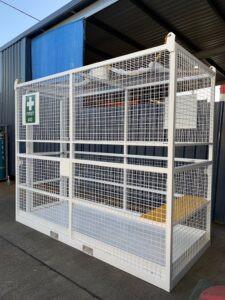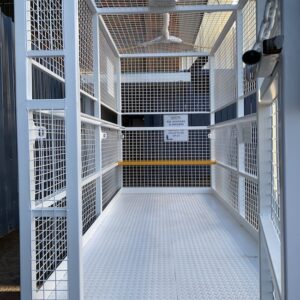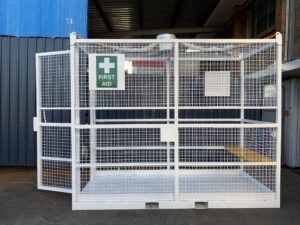Did you know that labourers are ranked as Australia’s Number 1 most at risk workers?
In 2019, a total of 171 workers died from an injury sustained at work in Australia. The most deaths racked up in labour sectors like construction.
Thankfully, we are all doing our best to mitigate this statistic. This is why Safe Work Australia constantly strives to develop national policy related to Workplace Health and Safety (WHS).
SWA produces and refers to national strategies, research, and data related to workplace safety in order to suggest changes to reduce the number of Australian deaths.
Those national strategies now include references to work boxes and crane lift first aid rescue cages.
Work Boxes and Crane Lift Rescue Cages
A work box is a personnel carrying device designed to be suspended from a crane, in order to provide a working area for a person elevated by and working from the device.
Crane Lift Rescue Cages, also referred to as Crane First Aid Rescue Cages, are a type of work box or lifting cage.
SWA now have stringent requirements surrounding the need for and use of First aid rescue boxes in order to actively protect the lives of workers.

Regulations of Crane Lift First Aid Rescue Cages
Under the Safe Work Australia regulations, Crane Lift First Aid Rescue Cages should be clearly identified and marked as first aid boxes and only be used for rescue and evacuation on worksites where injured personnel need to be safely evacuated.
This means that you cannot expect to use a standard crane lift man cage, lifting cage, or bin to meet the requirement for a Crane Lift First Aid Rescue Cage on site.
It is also a mandatory requirement of AS1418.17 that suspension sling sets are supplied as an integral component of a crane lift first aid rescue cage. If you are using or are offered a cage without dedicated chains or slings, that cage does not comply with Australian Standards and Design Registration requirements and should not be considered for the use of hoisting personnel.
Features of a Quality Crane Lift First Aid Rescue Cage

The following list should be checked off when sourcing or procuring a Crane Lift First Aid Rescue Cage for your work site:
– Designed for a standard rescue stretcher to lay down in the box
– Self-closing and self-locking gate
– Supplied with lifting lugs for overhead crane lifts
– Tested and fully certified
– Supplied with chains and zinc or powder-coated finish
– Able to transport up to 6 personnel
– Full height outward opening gate (manoeuvrable with the stretcher occupied)
– Fully enclosed mesh cage (providing completed protection to occupants)
– Seat or bench for use by non-stretchered workers
– Safety harness anchor points and internal handrails
– Fork pockets (for empty cage transport and positional purposes only)
Crane requirements
- If a crane is to lift a Crane Lift First Aid Rescue Cage, then it is mandated that the crane should meet the following standards.
- The crane ought to be equipped with a secondary backup system that will prevent the load from falling if the primary lifting device fails.
- The crane must have a minimum rated capacity of at least twice the total load of the workbox and its contents at the maximum radius for the task to be performed, and not less than 1000 kg.
- The crane needs to be fitted with an upper hoist limit—anti-two block—that stops the operation of the hoist, luff and telescope functions of the crane or be designed so that two-blocking cannot damage part of the crane or lifting gear.
- The crane is expected to have levers and foot pedals fitted with a constant pressure system so that crane motion stops immediately once the operator removes pressure from the controls.
- If the crane is fitted with a free fall facility, then this function must be positively locked out to prevent inadvertent activation when lifting a work box.
- Where a crane has a brake acting directly on the drum, the braking efficiency of the hoisting drive train should be tested by hoisting and holding a load that is:
(a) equivalent to the line pull of the hoist winch, or
(b) not less than twice the maximum hoisted load. - If the crane will be used to lift other loads the test needs to be repeated before re-lifting the work box.
- During operation of the crane with a work box the line pull of the hoist winch should not exceed that used in the test.
Final Facts

Work performed in a Crane Lift First Aid Rescue Cage is to be limited to special tasks of short duration, in situations where necessary to elevate personnel where it is not practicable to erect scaffolds or use a specially designed device including crane lifting equipment.
The Cage must be manufactured to suit First Aid Rescue applications – including an outward opening gate for stretcher, and the Fork Arm slipper pockets are to be used for transport purposes only when the cage is empty.
Always purchase your crane attachments and any crane lift first aid rescue cage from a quality Australian crane cage manufacturer who undertakes extensive testing and meets the Australian Standard and all WH&S requirements.
